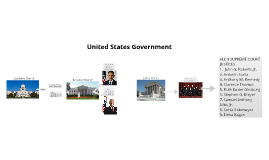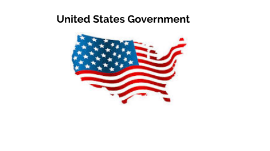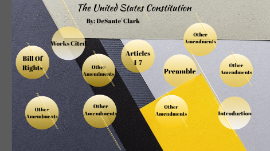US Government Presentation
Transcript: United States Government Declaration of Independence Declaration of Independence Declaration Of Independence Statement of Independence was first discussed June 7, 1776 by Richard Henry Lee Original draft by John Adams, Benjamin Franklin, Thomas Jefferson, Robert R. Livingston and Roger Sherman July 2, 1776 congress voted to declare independence from England July 4, 1776 congress accepted the Declaration of Independence Articles of Confederation Articles of Confederation American Revolutionay War (1775-1783) created new states in the U.S. Congress selects John Dickinson to draft a federal Constitution. Articles of Confedertion - first example of a Constitutional agreement between the 13 former colonies. Submitted July 12, 1776 Adopted November 15, 1777 Ratified by 13 American States, Maryland 1781 Composed of a Preamble and 13 Articles Covered voting and taxes by states, and all 13 states had to agree to an amendment of the Federal Government US Constitution US Constitution A "Living" document because it is able to be amended Preamble Preamble Describes the purpose of the document and the Federal Government Seven Articles Seven Articles Establishes how the Government is structured and how the constitution can be changed Amendments Amendments Lists changes to the Constitution (Bill of Rights is the first 10) Bill of Rights Bill of Rights Formed in addition to the Constitution to protect some basic human rights Added to the Constitution on December 15, 1791 First Amendment First Amendment Freedom of Religion Freedom of Speech Freedom of the Press Freedom of Assembly Second Amendment Second Amendment Right to keep and bear arms Third Amendment Third Amendment Restricts housing soldiers in private homes Fourth Amendment Fourth Amendment Protects against unreasonable search and seizure Fifth Amendment Fifth Amendment Protects against self testimony, being tried twice for the same crime and seizure of property Sixth Amendment Sixth Amendment Right to a speedy trial, trial by jury and the services of lawyer Seventh Amendment Seventh Amendment Guarantees trial by jury in cases of a certain dollar amount Eighth Amendment Eighth Amendment Prohibits excessive bail or fines and cruel and unusual punishment Ninth Amendment Ninth Amendment States the list of rights (in the bill of rights) does not mean that other rights are not in effect Tenth Amendment Tenth Amendment Power not granted to the Federal Government is reserved for States or Individuals Branches of Government Branches of Government Legislative Branch Legislative Branch Established by Article I of the Constitution Two Houses: Senate and House of Representatives Regulates: Commerce, passing laws, taxes, post offices, post roats, punishes piracies and felonies on the seas and establishes requirements to run for Congress Executive Branch Executive Branch The President is established in Article II of the Constitution Limits term to 4 years Chooses Vice President President must give State of Union Addresses to Congress Allows pardons (not of impeachment) President must appoint ambassadors and Supreme Court Justices Judicial Branch Judicial Branch Established in Article III of the Constitution Consists of the Supreme Court (the highest court in the nation) Decides if a law is constitutional "Checks and Balances" of Government How Bills are Made Bills can either start in the House of Representatives or the Senate. If they start in the House, then they are voted on second by the Senate. If started in the Senate, they are voted on second by the House. How Bills are Made Bill Introduction in the House of Representatives Bill Introduction in the House of Representatives A Representative sponsors a bill and submits it to the Clerk of the House.Clerk assigns a legislative number, and Government Publishing Office prints the bill. Speaker of the House assigns bill to one of the 22 committees for review. Committee studies bill and either passes it, revises it, or lays it aside. If released, the House Committe decides the date it will be voted on and it is put on the calendar. Bill must pass with 2/3 vote. Bill then goes to the House of Representatives, where it is read and then amended if needed. A third reading occurs and if 218 votes out 235 are cast for the bill and it then passes to the senate. Bill in the Senate A Senator must introduce a bill when he or she is recognized by the presiding office. The presiding officer then assigns the bill to one of the 20 standing committes for review. Senate committe then votes to release the bill or lay it aside. If released, it goes to the senate floor where it needs 51 of 100 votes for it to pass. Bill then goes to a third committe consisting of both the House and the Senate, where it is revised to please both houses and then sent back to both for final review. Once approved it is printed by the Government Publishing office in a process called enrolling. Bill then goes back to the House it originated in and is certified. It is then

















